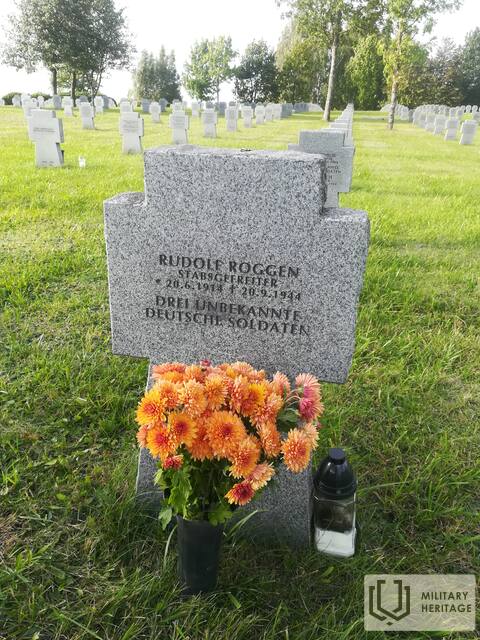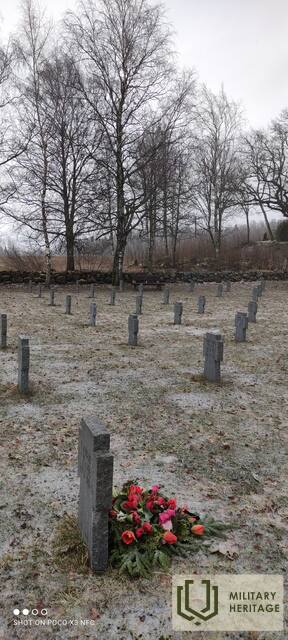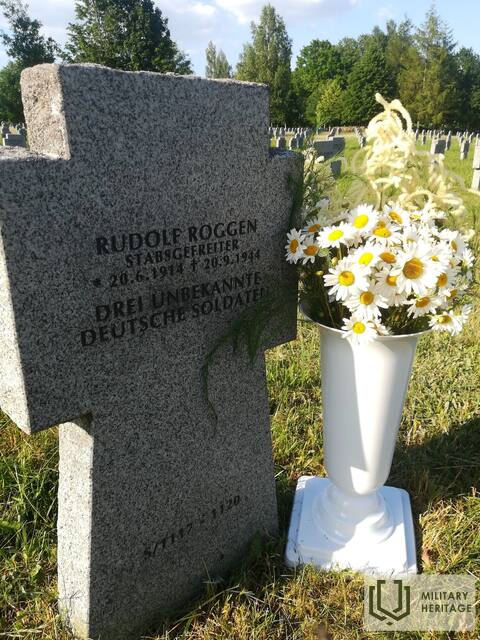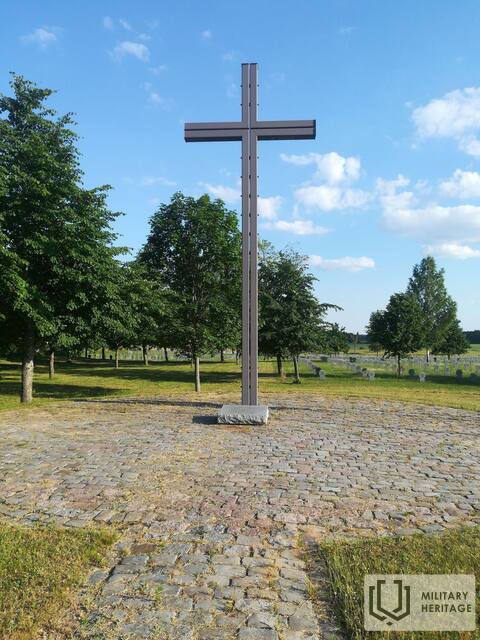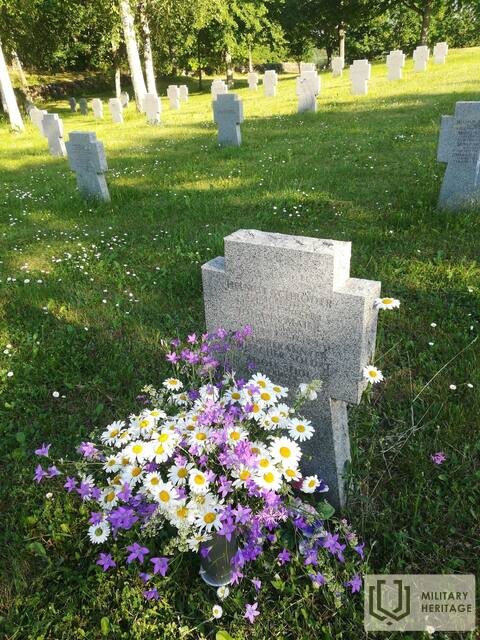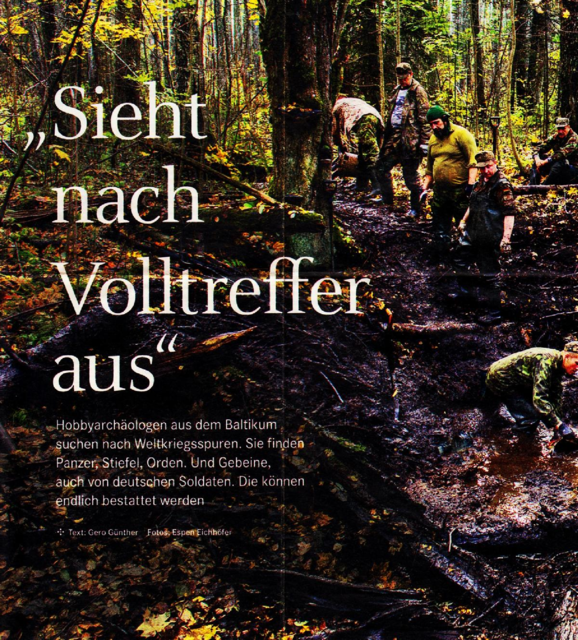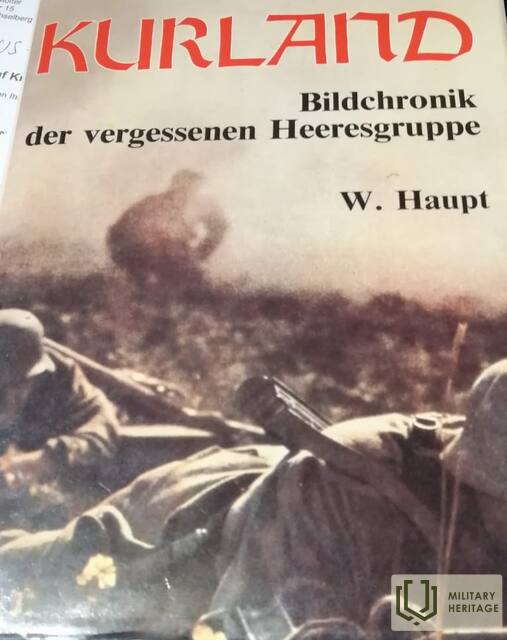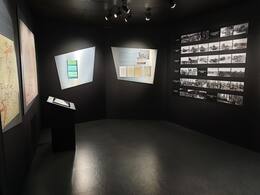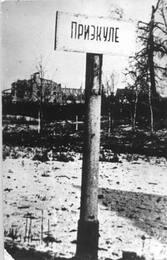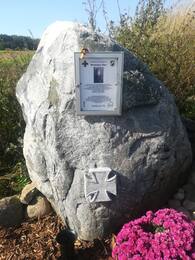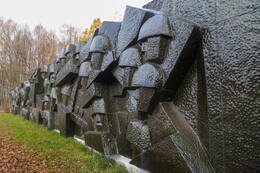"Война не закончена, пока не похоронен последний солдат" (Солдусское немецкое солдатское кладбище)
Kurzeme tekkis 10. oktoobril 1944 eraldi ja eraldi lahinguväljana. Umbes 500 000 Saksa sõjaväelast loeti ümberpiiratuks. 1. Balti rinde staabi aruannete kohaselt oli kogu Läänemere ranniku täielikuks vabastamiseks vaja vaid "väikest pingutust". Siiski jätkusid lahingud Kuramaal veel seitse kuud ja Kuramaast sai Teise maailmasõja lõpu sümbol.
Seitse kuud kestnud lahingutegevuse jooksul kuni 1945. aasta maini kaotasid Saksa väed Kuramaal 154 108 sõdurit hukkununa, haavatuna ja kadununa. Alates 1997. aastast on Salduse lähedal läbi viidud sõjaaja kalmistu uuring ja sõdurite ümbermatmine ning praegu on siin 27 000 langenud sõduri nime.
Kurzeme tekkis 10. oktoobril 1944 eraldi ja eraldi lahinguväljana. Punaarmee oli püüdnud ära kasutada edu Valgevenes alates 1944. aasta juuli lõpust, kus Saksa armeegrupp "Kesk" hävitati vähem kui kuu ajaga. Augusti alguses 1944 vallutasid Nõukogude 3. kaardiväe mehhaniseeritud korpuse üksused Tukumsi ja jõudsid Riia lahe ääres asuvasse Klapkalntsiasse, katkestades maismaaliiklus Wehrmachti Põhja armeegrupi ja Saksamaa vahel. Punaarmee esimene katse liikluse katkestamiseks jäi siiski ebaõnnestunuks, sest Saksa vasturünnaku tulemusena taastati maismaakoridor Tukumsi juures juba 1944. aasta augusti lõpus.
Järgmine katse Saksa armee ümberpiiramiseks algas 14. septembril 1944, kui kolm Balti rindeüksust 1 546 000 sõduriga alustasid pealetungi Riia suunas. Ka see katse ebaõnnestus ja Punaarmee pidi oma plaane muutma. Kolmas katse, mida tuntakse "Klaipėda pealetungi" nime all, ei olnud mitte ainult edukas, vaid sellest sai üks Punaarmee suurimaid saavutusi Teise maailmasõja ajal. 5. panzerarmee, mis alustas oma rünnakut 5. oktoobril, jõudis 10. oktoobri õhtul Palanga lähedal Läänemere rannikule.
Umbes 500 000 Saksa väeosa oli hinnanguliselt ümber piiratud. 1. Balti rinde staabi aruannete kohaselt oli kogu Läänemere ranniku täielikuks vabastamiseks vaja vaid väikest pingutust. Siiski jätkusid lahingud Kuramaal veel seitse kuud ja Kuramaast sai Teise maailmasõja lõpu sümbol.
Seitse kuud kestnud lahingutegevuse jooksul kuni 1945. aasta maini kaotasid Saksa väed Kuramaal 154 108 sõdurit hukkununa, haavatuna ja kadununa. Surnute ja kadunute täpne arv ei ole teada, kuid see võis ulatuda kuni 50 000 inimeseni. Pärast sõja lõppu hävitasid nõukogude võimud saksa sõdurite kalmistud. Langenud sõdurite ekshumeerimine lahinguväljadelt ja hävitatud kalmistutelt algas 1990. aastate alguses.
Alates 1997. aastast on alustatud Salduse lähedal asuvate sõjahaudade uurimist ja ümbermatmist ning praegu on siin 27 000 langenud sõduri nime. Töö on veel pooleli, sest kõiki matmispaiku ei ole veel uuritud. Ümbermatmise käigus leitud sõdurite nimedest selgub, et sakslaste ja austerlaste seas oli saksa sõjaväes ka lätlasi, eestlasi, leedulasi, norralasi, taanlasi ja teisi rahvusi.
Seotud ajajoon
Seotud teemad
Seotud objektid
Кладбище немецких солдат в Салдусе
Салдусское кладбище немецких солдат расположено на трассе Салдус-Эзере. На кладбище площадью 8 гектаров было перезахоронено около 25 000 немецких солдат, а также несколько латвийских легионеров. Перезахоронения происходят с 1997 года.
С 1 мая по 1 октября в мемориальном зале можно увидеть экспозицию, посвященную Курземской битве. В этот период мемориальная комната открыта по будням с 9:00 до 17:00, по субботам и воскресеньям на кладбище также работает экскурсовод. Также доступны реестры солдат, похороненных в Салдусских могилах немецких солдат, и павших солдат по всей Латвии.
Хранилище культурно-исторических и краеведческих материалов «Таможня» в Эзере
Дом «Таможня» находится в Эзере, недалеко от дороги Салдус - Мажейкяй у латвийско-литовской границы. 8 мая 1945 года в этом здании был подписан акт о капитуляции немецкой группы армий «Курляндия» (Kurland), запертой в Курляндском котле. Считается, что в Эзере фактически закончилась Вторая мировая война. В доме таможне размещена экспозиция о событиях конца Второй мировой войны и экспозиции истории Эзереской волости с древних времён и до наших дней.
Утром 7 мая 1945 года командующий Ленинградским фронтом маршал Л. Говоров направил руководству группы армий «Курземе» ультиматум с требованием сложить оружие. Стороны подписали акт о капитуляции 8 мая, предусмотрев нем процедуру капитуляции, пункты сбора оружия, объем документов и информации, которые необходимо предоставить, и другие практические мероприятия.
Guided excursion in Priekule “Along the Footsteps of World War II in the "Courland Pocket””
The guided tours feature the battlefields of World War II in the vicinity of the town of Priekule. The duration of the tour can be adjusted to suit the interests of the group: from 10 kilometres in three hours to 40 kilometres in six hours. All year round, the tours are available in Latvian, Russian and English. Tours must be booked in advance. The tours are suitable for travellers from 13 years of age. The most suitable mode of transportation is a car or bus with up to 30 seats. Key stops: Gramzda parish where the Soviet Army initiated its attack on the German Army in Priekule in the autumn of 1944. Priekule Brothers’ Cemetery: the largest Brothers’ Cemetery in the Baltics with more than 23,000 Red Army soldiers resting here. Priekule: a site of strategic importance in the south of the ‘Courland Pocket’ where a particularly heavy and difficult battle was fought. Krote parish where in the February of 1945 the attack of the Soviet Army on the German forces besieged in the ‘Courland Pocket’ stopped on the banks of the Vārtāja river.
Memorial site for Hermann Faul
It is located at the crossroads of rural roads, turning off the road leading from Pienava to Džūkste.
Memorial to H. Faul, and to the nine German and Latvian soldiers who fell in the battle of 27 December 1944 (probably blown up by a direct hit from a cannon shell) and who are presumed missing since then, as no remains, documents or other evidence of their identity have been found.
Priekule Memorial Ensemble of Warrior’s Cemetery
The Priekule Memorial Ensemble of Warrior’s Cemetery is on the Liepāja-Priekule-Skoda road and is the largest burial site of Soviet soldiers of World War II in the Baltics. More than 23,000 Soviet soldiers are buried here. Operation Priekule was one of the fiercest battles in Kurzeme Fortress that took place from October 1944 to 21 February 1945. The Battle of Priekule in February 1945 lasted seven days and nights without interruption and had a lot of casualties on both sides. Until Priekule Warrior’s Cemetery was transformed into a memorial, the last monument of the outstanding Latvian sculptor K. Zāle (1888-1942) was located here to commemorate the independence battles in Aloja. Between 1974 and 1984, the 8 ha Priekule Warrior’s Cemetery was transformed into a memorial ensemble dedicated to those who fell in World War II. It was designed by the sculptor P. Zaļkalne, architects A. Zoldners and E. Salguss, and the dendrologist A. Lasis.
The centre of the memorial holds a 12 m tall statue called the ‘Motherland’, and names of the fallen are engraved on granite slabs. Until Latvia regained its independence, the Victory Day was widely celebrated every year on May 9.
Guided excursion in Priekule “Along the Footsteps of World War II in the "Courland Pocket””
The guided tours feature the battlefields of World War II in the vicinity of the town of Priekule. The duration of the tour can be adjusted to suit the interests of the group: from 10 kilometres in three hours to 40 kilometres in six hours. All year round, the tours are available in Latvian, Russian and English. Tours must be booked in advance. The tours are suitable for travellers from 13 years of age. The most suitable mode of transportation is a car or bus with up to 30 seats. Key stops: Gramzda parish where the Soviet Army initiated its attack on the German Army in Priekule in the autumn of 1944. Priekule Brothers’ Cemetery: the largest Brothers’ Cemetery in the Baltics with more than 23,000 Red Army soldiers resting here. Priekule: a site of strategic importance in the south of the ‘Courland Pocket’ where a particularly heavy and difficult battle was fought. Krote parish where in the February of 1945 the attack of the Soviet Army on the German forces besieged in the ‘Courland Pocket’ stopped on the banks of the Vārtāja river.




